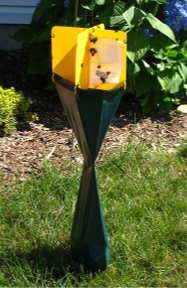Managing Japanese Beetles
 This information is provided by the Russell Township Environmental and Sustainability Advisory Committee to help you make informed decisions on the management of Japanese Beetles around your property in urban areas of the Township.
This information is provided by the Russell Township Environmental and Sustainability Advisory Committee to help you make informed decisions on the management of Japanese Beetles around your property in urban areas of the Township.
When we think of the end of June, we think summer holidays, the end of school and slower days. But some think of other things. The Japanese Beetles, for example, think its time to get out of bed, put their adult clothes on and get to work! The grubs that have been finding safe haven in your grass, eating its roots, metamorphosize from a larva into a beetle.
Millions of these new beetles emerge with two things on their minds: eat as much as they can and mate often to keep their species going. So, prepare yourselves, because here they come!
What Can I Do?
Here are some things you can do and some things you shouldn’t do!
Do:
- Handpick them off if you have the stomach for it and drop them into hot soapy water. Every beetle that you get means fewer beetles in the long run.
- You can cover herbs and plants that don’t need pollinators with light insect mesh. Amazon carries them. Stroller covers work well too.
- Plant flowers and herbs that attract winsome flies to your yard. These parasitic flies will lay eggs on the female beetles. Within 24 hours the larva will hatch and will feed off the beetle, killing it. The winsome fly feed on the nectar of umbellifers (umbrella-shaped flower clusters) and shallow flowers and will be attracted to these plants.
Here is a list:
- Herbs: dill, coriander, parsley, fennel, and lovage.
- Native plants that attract the Winsome flies: Golden Alexander, Purple stemmed Angelica, yarrow, native Black-eyed Susan Hirta, Rattlesnake master, swamp aster, and wild bergamot.
- Non-native plants: Queen Anne’s lace, marigolds, sweet alyssum, daisies, and chamomile.

The winsome fly lays eggs on the backs of the Japanese beetles. The white dots are the eggs.
- If adding garden plants, add plants that the beetles avoid such as milkweed, yarrow, plants in the onion family. Here is a list.
- Add beneficial nematodes to your grass that correspond to when the beetles are in the larval stage, and they will eat them.
- Get rid of your lawn! There are other choices for lawns that are more beneficial for our earth that the beetle larva will not eat such as Prunella self-heal or clover.

These are in your grass! Japanese beetle larva and pupa.
Do NOT:
 Do not use traps. Traps attract them to your yard and your neighbour’s yard.
Do not use traps. Traps attract them to your yard and your neighbour’s yard.- Do not squish Japanese beetles. When you squish them, they excrete hormones that attract other Japanese beetles.
- Do not spray them with insecticide. It will kill other beneficial insects.
- Do not plant the species that the beetles like to eat. Here is a list of some:
- Trees: Maple, poplar, fruit, oak, willows, elder, and elm.
- Plants: butterfly bush, thistle, daylily, hibiscus, hop, hydrangea, impatient, lilacs, basil, mint, gooseberries, rhubarb, raspberries, blackberries, blueberries, grapes, maize, potatoes, tomatoes, spinach, and others.
